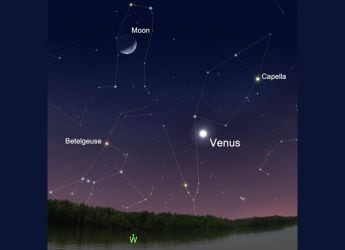- Home
- Science
- Science News
- Two Spacecraft Recreate Artificial Solar Eclipses to Observe the Sun’s Superhot Corona
Two Spacecraft Recreate Artificial Solar Eclipses to Observe the Sun’s Superhot Corona
Two ESA spacecraft successfully recreated solar eclipses from space to study the sun’s blazing corona.

Photo Credit: ESA
ESA’s twin spacecraft recreate solar eclipses to capture stunning images of the sun’s corona.
Two spacecraft have achieved a rare milestone: recreating a total solar eclipse in space. The European Space Agency's (ESA) Proba-3 mission released the first images on June 16 from a successful test where one satellite blocked the sun's light, allowing the other to capture the blazing outer atmosphere—the corona. Unlike fleeting eclipses on Earth, this artificial version offers prolonged, repeated observations. “We could see the corona without any special image processing,” said Andrei Zhukov of the Royal Observatory of Belgium. “It was just visible there, like during a natural total solar eclipse.”
ESA's Proba-3 Spacecraft Recreates Eclipses to Study Sun's Million-Degree Corona in Unprecedented Detail
As per ESA reports, the Proba-3 spacecraft orbits Earth in an elliptical path, up to 60,000 kilometres at the far end. During alignment, they float a mere 150 metres apart, one satellite casting an accurate shadow on the other. This method allows scientists to block the sun's brightly radiant disk and view the faint, million-degree corona, which is some 200 times hotter than the sun's visible surface and can be observed only during total eclipses. The middle layer is where scientists think answers to why this outer region is so blisteringly hot may be found.
So far, the twin satellites have completed nine test eclipses, with the goal of performing two per week. While natural eclipses only happen every 18 months or so and last just a matter of minutes, Proba-3 could replicate an eclipse every 20 hours and prolong it for up to six hours. This capability gives scientists a unique opportunity to investigate in detail the solar corona's dynamic and magnetic activity.
Proba-3 was lifted off to orbit from India on December 5. Over the next two years, the spacecraft is anticipated to provide upwards of 1,000 hours of eclipse data. The discovery not only makes it possible to systematically observe solar behavior but also helps to enhance the forecasts of solar weather needed to protect satellites and power grids.
ESA officials view this as a new era in heliophysics, where man-made eclipses will fill the observational gap left by the rarity of total solar eclipses on Earth. With each orbit and eclipse, scientists inch closer to solving the long-standing mysteries of our star's fiery halo.
Get your daily dose of tech news, reviews, and insights, in under 80 characters on Gadgets 360 Turbo. Connect with fellow tech lovers on our Forum. Follow us on X, Facebook, WhatsApp, Threads and Google News for instant updates. Catch all the action on our YouTube channel.
Related Stories
- Samsung Galaxy Unpacked 2025
- ChatGPT
- Redmi Note 14 Pro+
- iPhone 16
- Apple Vision Pro
- Oneplus 12
- OnePlus Nord CE 3 Lite 5G
- iPhone 13
- Xiaomi 14 Pro
- Oppo Find N3
- Tecno Spark Go (2023)
- Realme V30
- Best Phones Under 25000
- Samsung Galaxy S24 Series
- Cryptocurrency
- iQoo 12
- Samsung Galaxy S24 Ultra
- Giottus
- Samsung Galaxy Z Flip 5
- Apple 'Scary Fast'
- Housefull 5
- GoPro Hero 12 Black Review
- Invincible Season 2
- JioGlass
- HD Ready TV
- Laptop Under 50000
- Smartwatch Under 10000
- Latest Mobile Phones
- Compare Phones
- Xiaomi 17 Ultra Leica Edition
- Xiaomi 17 Ultra
- Huawei Nova 15
- Huawei Nova 15 Pro
- Huawei Nova 15 Ultra
- OnePlus 15R
- Realme Narzo 90x 5G
- Realme Narzo 90 5G
- Asus ProArt P16
- MacBook Pro 14-inch (M5, 2025)
- OPPO Pad Air 5
- Huawei MatePad 11.5 (2026)
- Huawei Watch 10th Anniversary Edition
- OnePlus Watch Lite
- Acerpure Nitro Z Series 100-inch QLED TV
- Samsung 43 Inch LED Ultra HD (4K) Smart TV (UA43UE81AFULXL)
- Asus ROG Ally
- Nintendo Switch Lite
- Haier 1.6 Ton 5 Star Inverter Split AC (HSU19G-MZAID5BN-INV)
- Haier 1.6 Ton 5 Star Inverter Split AC (HSU19G-MZAIM5BN-INV)

















